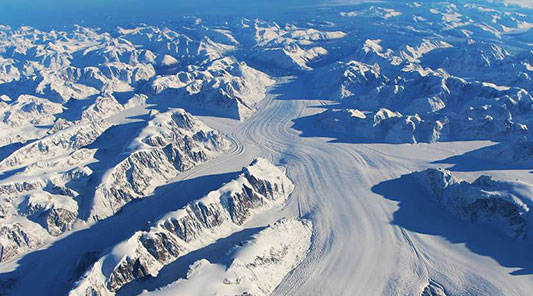CReSIS


With the StorNext platform, we now have a single file system that manages our entire multitier storage solution, from tape to primary disk to the HPC cluster.

IT Engineer, Center for Remote Sensing of Ice Sheets, University of Kansas

CReSIS Measures The Impact Of Sea Level Change with StorNext
Led by a team at the University of Kansas, the Center for Remote Sensing of Ice Sheets (CReSIS) uses radar to image and track changes in ice sheets in Greenland and Antarctica. CReSIS needed a new solution to store growing data volumes.
Using Radar to See Through Ice Layers
Established in 2005 by an award from the National Science Foundation, CReSIS helps precisely measure changes in the earth’s ice sheets. Researchers use advanced radar often attached to the underbellies of planes. “By mapping the layers, the bed, and the top of glaciers in Greenland and Antarctica, scientists can assess current effects of climate change on ice and predict its future impact,” says Riley Epperson, IT engineer for CReSIS.
Collecting Up to 150TB of Scientific Data per Mission
The amount of data collected per mission has grown dramatically over time. “In 2005, researchers might have collected 100GB per mission,” says Epperson. “But in the years since then, our engineers have continued to enhance the capabilities of radar systems. Today’s systems can provide much greater resolution of the ice layers. As a result, researchers now bring home closer to 150TB per mission.”
As the amounts of raw data collected in the field grow, workflows can slow. “The more data researchers collect, the more time we spend ingesting, verifying, and cleansing that data,” says Epperson. “We needed a solution that would help us improve the efficiency of our workflow.”
Searching for a High-Performance Storage Platform That Scales
The CReSIS IT group decided to change the file system it was using to store and manage research data. “We needed a new approach to the large and growing data volumes while also allowing us to continue to use our existing storage,” says Epperson.
The IT group also wanted a file system that could help increase throughput. “Collaborators and partners need to analyze and process the data that we ingest so they can generate the products required for research,” says Epperson. “With some partners, such as NASA, we are expected to turn around data within a particular timeframe.”
Requiring a Solution That Scales More Cost-Effectively
The CReSIS IT group needed data management capabilities that could support a multi-tier environment. “We ingest raw data only two to three times per year, then it just sits—approximately 80 percent of our data is cold,” says Epperson. “We wanted a solution that would enable us to easily move cold data to tape and then retrieve it later on.”
Building a More Flexible, Large-Scale Storage Environment with StorNext
After evaluating a variety of new file systems and data management solutions, the CReSIS team selected the Quantum StorNext® platform. Powered by StorNext data management software, the solution includes a high-performance shared file system and policy-driven tiering software.
Selecting the StorNext platform enabled the CReSIS team to continue to use an aging primary disk while also adding a tape archive tier. “With the StorNext platform, we now have a single file system that manages our entire multi-tier storage solution, from tape to primary disk to the HPC cluster,” says Epperson.
Speeding Up Ingest and Enabling HPC Workflows for Climate Research
StorNext eliminates the pool size limitations imposed by the team’s previous file system. CReSIS now has 600 disks on a single file system instead of only 100 in the past. The result is superior performance.
“We have more than tripled our storage performance compared with the previous environment,” says Epperson. “StorNext helps us ingest and process growing collections of data faster while continuing to meet our existing deadlines.”
High-speed storage helps speed up the overall workflow. “The faster we can move data into our HPC cluster for processing, the faster we can deliver it to researchers,” says Epperson.
Controlling Costs with a Multi-Tier Storage Solution
Moving to the StorNext platform has enabled CReSIS to expand its storage environment while keeping costs under control by using economical tape archives. The cost savings have added up quickly. “StorNext offers a strong return on investment,” says Epperson.
StorNext also provides the flexibility to meet unpredictable changes in storage requirements. “We don’t have a consistent rate of data growth from year to year,” says Epperson. “Each time engineers create a new radar system, we might need to store five times as much data per mission. With StorNext we can quickly scale to meet those requirements.”


